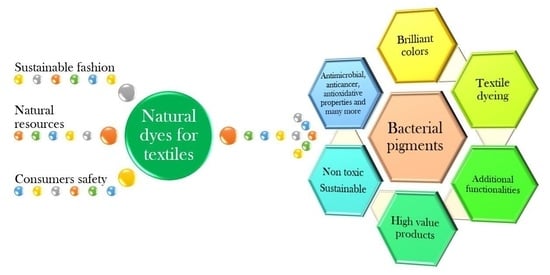Bacterial Secondary Metabolites as Biopigments for Textile Dyeing
Abstract
:1. Introduction
2. Bacterial Dyes
3. Dyeing of Textile Materials with Biopigments
3.1. Type of Bacteria Used for Textile Dyeing and Resulting Color
| Pigment/Active Substance | Textile Material | Color of Pigment/Color of Dyed Material | Use of Mordants | Reference |
|---|---|---|---|---|
| Chromobacterium violaceum UTM5/violacein | cotton, silk, rayon, polyester | violet/dark blue | alum, Fe2(SO4)3, CuSO4, Ca(OH)2 | [20] |
| Janthinobacterium lividu/violacein | polyamide 6.6 | deep purple/purple | / | [17] |
| Serratia marcescens SB08/prodigiosin | cotton, silk | dark red/pink | Na2SO4 | [21,22] |
| Serratia marcescens /prodigiosin | cotton, nylon, polyester, muslin, rubber | red/pink | / | [10] |
| Serratia rubidaea/prodigiosin | cotton, wool, polyester | dark pink/pink | FeSO4, CuSO4, NaHCO3, lemon | [23,24] |
| Serratia sakuensis/prodigiosin | cotton, silk, wool | red/red-pink | Na2SO4·10H2O | [25] |
| Rhodonellum psychrophylium GL8/prodigiosin | cotton, silk, rayon | dark red/red | NaCl | [26] |
| Serathia plymuthica/prodigiosin | bacterial cellulose, polyvinyl alchohol chitosan nanofibers | red/pink | / | [27] |
| Streptomyces virginiae/melanin | wool (dyeing and printing) | yellow, light brown, dark brown | / | [28] |
| Pseudomonas aureginosa/pyocyanin | polyester | blue-green/yellow | / | [29] |
| Serratia sp. KH-1/prodigiosin | cotton and wool | red/pink | tannic acid, FeSO4, CuSO4, NaCl, ammonium alum ((NH4)Al(SO4)2) | [30] |
| Pseudomonas sp. HOB1/indigo | cotton | blue/blue | aluminum, NaOH | [31] |
| Streptomyces sp. NP2 and NP4/prodigiosin | multifiber fabric | dark red/red-pink | / | [18] |
| Streptomyces sp. NP4/prodigiosin | viscose | dark red/red-blue | / | [32] |
3.2. Dyeing Procedure Using Biopigments
3.3. The pH and Temperature Used for Dyeing Textiles with Biopigments
3.4. Mordants Used for Dyeing Textile with Biopigments
4. Other Properties of Biopigments for Obtaining Functional Textile Materials
5. Conclusions
Author Contributions
Funding
Institutional Review Board Statement
Informed Consent Statement
Data Availability Statement
Acknowledgments
Conflicts of Interest
Abbreviations
| AgNP | silver nanoparticles |
| BC | bacterial cellulose |
| CH | chitosan |
| PA 6.6 | polyamide 6.6 |
| PAN | polyacrylonitrile |
| PES | polyester |
| PVA | poly (vinyl alcohol) |
| TEMPO | (2,2,6,6-Tetramethylpiperidin-1-yl) oxyl |
| UV | ultraviolet |
References
- Bechtold, T.; Turcanu, A.; Ganglberger, E.; Geissler, S. Natural dyes in modern textile dyehouses-How to combine experiences of two centuries to meet the demands of the future? J. Clean. Prod. 2003, 11, 499–509. [Google Scholar] [CrossRef]
- Hill, D.J. Is there a future for natural dyes? Rev. Prog. Color. Relat. Top. 1997, 27, 18–25. [Google Scholar] [CrossRef]
- Venil, C.K.; Zakaria, Z.A.; Ahmad, W.A. Bacterial pigments and their applications. Process Biochem. 2013, 48, 1065–1079. [Google Scholar] [CrossRef]
- Aman Mohammadi, M.; Ahangari, H.; Mousazadeh, S.; Hosseini, S.M.; Dufossé, L. Microbial pigments as an alternative to synthetic dyes and food additives: A brief review of recent studies. Bioprocess Biosyst. Eng. 2022, 45, 1–12. [Google Scholar] [CrossRef]
- Narsing Rao, M.P.; Xiao, M.; Li, W.J. Fungal and bacterial pigments: Secondary metabolites with wide applications. Front. Microbiol. 2017, 8, 1–13. [Google Scholar] [CrossRef]
- Vicente, A.; Hernández, F.G.; Thibaut, R.; Müller, A. Fungal dyes for textile applications: Testing of industrial conditions for wool fabrics dyeing. J. Text. Inst. 2019, 110, 61–66. [Google Scholar]
- Shirata, A.; Tsukamoto, T.; Yasui, H.; Hata, T.; Hayasaka, S.; Kojima, A.; Kato, H. Isolation of bacteria producing bluish-purple pigment and use for dyeing. Jpn. Agric. Res. Q. 2000, 34, 131–140. [Google Scholar]
- Alihosseini, F.; Ju, K.S.; Lango, J.; Hammock, B.D.; Sun, G. Antibacterial colorants: Characterization of prodiginines and their applications on textile materials. Biotechnol. Prog. 2008, 24, 742–747. [Google Scholar] [CrossRef] [Green Version]
- Venil, C.K.; Wahidin, M.A.B.; Aruldass, C.A.; Ahmad, W.A. Production of bacterial pigments in low cost medium and formulation of biodegradable ink. Indian J. Exp. Biol. 2017, 55, 441–447. [Google Scholar]
- El-Bialy, H.A.; Abou El-Nour, S.A. Physical and chemical stress on Serratia marcescens and studies on prodigiosin pigment production. Ann. Microbiol. 2015, 65, 59–68. [Google Scholar] [CrossRef]
- Mazotto, A.M.; De Ramos Silva, J.; De Brito, L.A.A.; Rocha, N.U.; De Souza Soares, A. How can microbiology help to improve sustainability in the fashion industry? Environ. Technol. Innov. 2021, 23, 101760. [Google Scholar] [CrossRef]
- Mumtaz, R.; Bashir, S.; Numan, M.; Shinwari, Z.K.; Ali, M. Pigments from Soil Bacteria and Their Therapeutic Properties: A Mini Review. Curr. Microbiol. 2019, 76, 783–790. [Google Scholar] [CrossRef]
- Stankovic, N.; Senerovic, L.; Ilic-Tomic, T.; Vasiljevic, B.; Nikodinovic-Runic, J. Properties and applications of undecylprodigiosin and other bacterial prodigiosins. Appl. Microbiol. Biotechnol. 2014, 98, 3841–3858. [Google Scholar] [CrossRef]
- Malik, K.; Tokkas, J.; Goyal, S. Microbial Pigments: A review. Int. J. Microb. Resour. Technol. 2012, 1, 361–365. [Google Scholar]
- Usman, H.M.; Abdulkadir, N.; Gani, M.; Maiturare, H.M. Bacterial Pigments and its Significance. MOJ Bioequivalence Bioavailab. 2017, 4, 285–288. [Google Scholar] [CrossRef] [Green Version]
- Alihosseini, F.; Lango, J.; Ju, K.S.; Hammock, B.D.; Sun, G. Mutation of bacterium Vibrio gazogenes for selective preparation of colorants. Biotechnol. Prog. 2010, 26, 352–360. [Google Scholar] [CrossRef] [Green Version]
- Kanelli, M.; Mandic, M.; Kalakona, M.; Vasilakos, S.; Kekos, D.; Nikodinovic-Runic, J.; Topakas, E. Microbial production of violacein and process optimization for dyeing polyamide fabrics with acquired antimicrobial properties. Front. Microbiol. 2018, 9, 1–13. [Google Scholar] [CrossRef] [Green Version]
- Kramar, A.; Ilic-Tomic, T.; Petkovic, M.; Radulović, N.; Kostic, M.; Jocic, D.; Nikodinovic-Runic, J. Crude bacterial extracts of two new Streptomyces sp. isolates as bio-colorants for textile dyeing. World J. Microbiol. Biotechnol. 2014, 30, 2231–2240. [Google Scholar] [CrossRef]
- Stankovic, N.; Radulovic, V.; Petkovic, M.; Vuckovic, I.; Jadranin, M.; Vasiljevic, B.; Nikodinovic-Runic, J. Streptomyces sp. JS520 produces exceptionally high quantities of undecylprodigiosin with antibacterial, antioxidative, and UV-protective properties. Appl. Microbiol. Biotechnol. 2012, 96, 1217–1231. [Google Scholar] [CrossRef]
- Venil, C.K.; Yusof, N.Z.; Aruldass, C.A.; Ahmad, W.A. Application of violet pigment from Chromobacterium violaceum UTM5 in textile dyeing. Biologia 2016, 71, 121–127. [Google Scholar] [CrossRef]
- Venil, C.K.; Dufossé, L.; Velmurugan, P.; Malathi, M.; Lakshmanaperumalsamy, P. Extraction and Application of Pigment from Serratia marcescens SB08, an Insect Enteric Gut Bacterium, for Textile Dyeing. Textiles 2021, 1, 3. [Google Scholar] [CrossRef]
- Ren, Y.; Gong, J.; Fu, R.; Zhang, J.; Fang, K.; Liu, X. Antibacterial dyeing of silk with prodigiosins suspention produced by liquid fermentation. J. Clean. Prod. 2018, 201, 648–656. [Google Scholar] [CrossRef]
- Siva, R.; Subha, K.; Bhakta, D.; Ghosh, A.R.; Babu, S. Characterization and enhanced production of prodigiosin from the spoiled coconut. Appl. Biochem. Biotechnol. 2012, 166, 187–196. [Google Scholar] [CrossRef]
- Metwally, R.A.; El Sikaily, A.; El-Sersy, N.A.; Ghozlan, H.A.; Sabry, S.A. Antimicrobial activity of textile fabrics dyed with prodigiosin pigment extracted from marine Serratia rubidaea RAM_Alex bacteria. Egypt. J. Aquat. Res. 2021, 47, 301–305. [Google Scholar] [CrossRef]
- Vaidyanathan, J.; Bhathena-Langdana, Z.; Adivarekar, R.V.; Nerurkar, M. Production, partial characterization, and use of a red biochrome produced by Serratia sakuensis subsp. nov strain KRED for dyeing natural fibers. Appl. Biochem. Biotechnol. 2012, 166, 321–335. [Google Scholar] [CrossRef]
- Bisht, G.; Srivastava, S.; Kulshreshtha, R.; Sourirajan, A.; Baumler, D.J.; Dev, K. Applications of red pigments from psychrophilic Rhodonellum psychrophilum GL8 in health, food and antimicrobial finishes on textiles. Process Biochem. 2020, 94, 15–29. [Google Scholar] [CrossRef]
- Amorim, L.F.A.; Mouro, C.; Riool, M.; Gouveia, I.C. Antimicrobial Food Packaging Based on Prodigiosin-Incorporated Double-Layered Bacterial Cellulose and Chitosan Composites. Polymers 2022, 14, 315. [Google Scholar] [CrossRef]
- Amal, A.M.; Abeer, K.A.; Samia, H.M.; Nadia, A.E.-N.H.; Ahmed, K.A.; El-Hennawi, H.M. Selection of pigment (melanin) production in Streptomyces and their application in printing and dyeing of wool fabrics. Res. J. Chem. Sci. 2011, 1, 22–28. [Google Scholar]
- Govindaraj, C.; Ugamoorthi, R.; Ramarethinam, S. Isolation of pseudomonas aeruginosa for bacterial pigment production and its application on synthetic knitted fabric. Indian J. Fibre Text. Res. 2021, 46, 168–173. [Google Scholar]
- Chauhan, K.; Dalsaniya, P.; Pathak, H. Optimization of prodigiosin-type biochrome production and effect of mordants on textile dyeing to improve dye fastness. Fibers Polym. 2015, 16, 802–808. [Google Scholar] [CrossRef]
- Pathak, H.; Madamwar, D. Biosynthesis of indigo dye by newly isolated naphthalene-degrading strain pseudomonas sp. HOB1 and its application in dyeing cotton fabric. Appl. Biochem. Biotechnol. 2010, 160, 1616–1626. [Google Scholar] [CrossRef] [PubMed]
- Kramar, A.D.; Ilic-Tomic, T.R.; Lađarević, J.M.; Nikodinovic-Runic, J.B.; Kostic, M.M. Halochromic cellulose textile obtained via dyeing with biocolorant isolated from Streptomyces sp. strain NP4. Cellulose 2021, 28, 8771–8784. [Google Scholar] [CrossRef]
- Kim, Y.; Choi, J. Dyeing properties of microbial prodiginine from Zooshikella rubidus for silk fabrics. Fibers Polym. 2015, 16, 1981–1987. [Google Scholar] [CrossRef]
- Gao, A.; Chen, H.; Hou, A.; Xie, K. Efficient antimicrobial silk composites using synergistic effects of violacein and silver nanoparticles. Mater. Sci. Eng. C 2019, 103, 109821. [Google Scholar] [CrossRef]
- Mohammed, S.J.; Luti, K.J.K. A kinetic model for prodigiosin production by Serratia marcescens as a bio-colorant in bioreactor. AIP Conf. Proc. 2020, 2213, 020027. [Google Scholar] [CrossRef]
- Chauhan, R.; Choudhuri, A.; Abraham, J. Evaluation of antimicrobial, cytotoxicity, and dyeing properties of prodigiosin produced by Serratia marcescens strain JAR8. Asian J. Pharm. Clin. Res. 2017, 10, 279–283. [Google Scholar] [CrossRef] [Green Version]
- Gong, J.; Ren, Y.; Fu, R.; Li, Z.; Zhang, J. pH-mediated antibacterial dyeing of cotton with prodigiosins nanomicelles produced by microbial fermentation. Polymers 2017, 9, 468. [Google Scholar] [CrossRef] [Green Version]
- Shahid, M.; Shahid-Ul-Islam; Mohammad, F. Recent advancements in natural dye applications: A review. J. Clean. Prod. 2013, 53, 310–331. [Google Scholar] [CrossRef]
- Chakraborty, I.; Redkar, P.; Munjal, M.; Sathish Kumar, S.R.; Bhaskara Rao, K.V. Isolation and characterization of pigment producing marine actinobacteria from mangrove soil and applications of bio-pigments. Der Pharm. Lett. 2015, 7, 93–100. [Google Scholar]
- Khaksar, F.; Rigi, G.; Mirdamadian, S.H. Creation of a violacein pigment hybrid with silver and titanium dioxide nanoparticles to produce multifunctional textiles with antimicrobial properties. Nanomed. Res. J. 2021, 6, 60–72. [Google Scholar] [CrossRef]



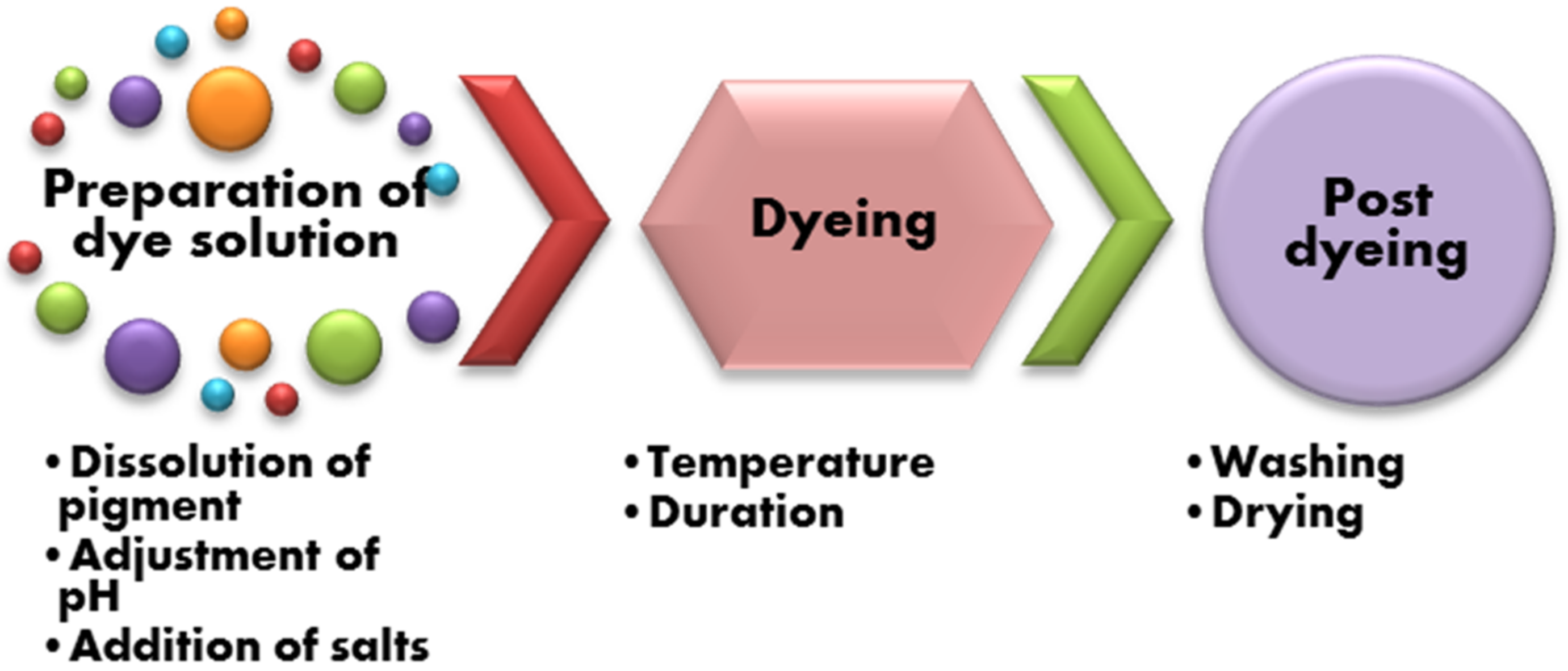


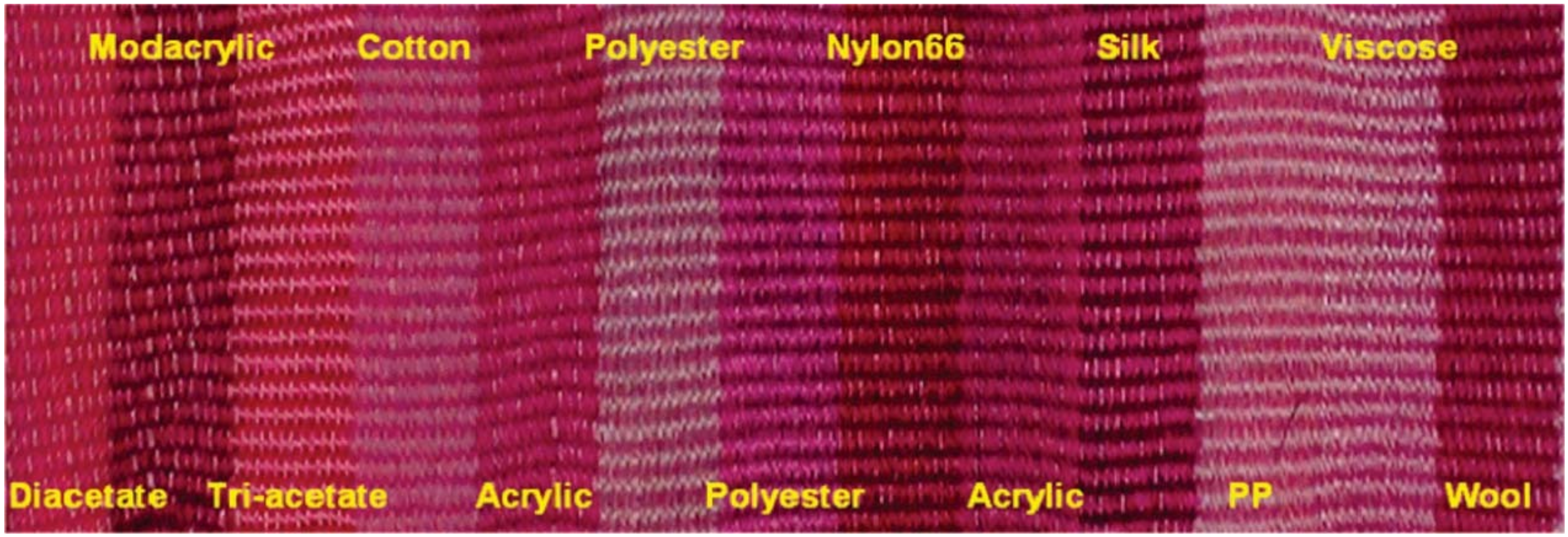
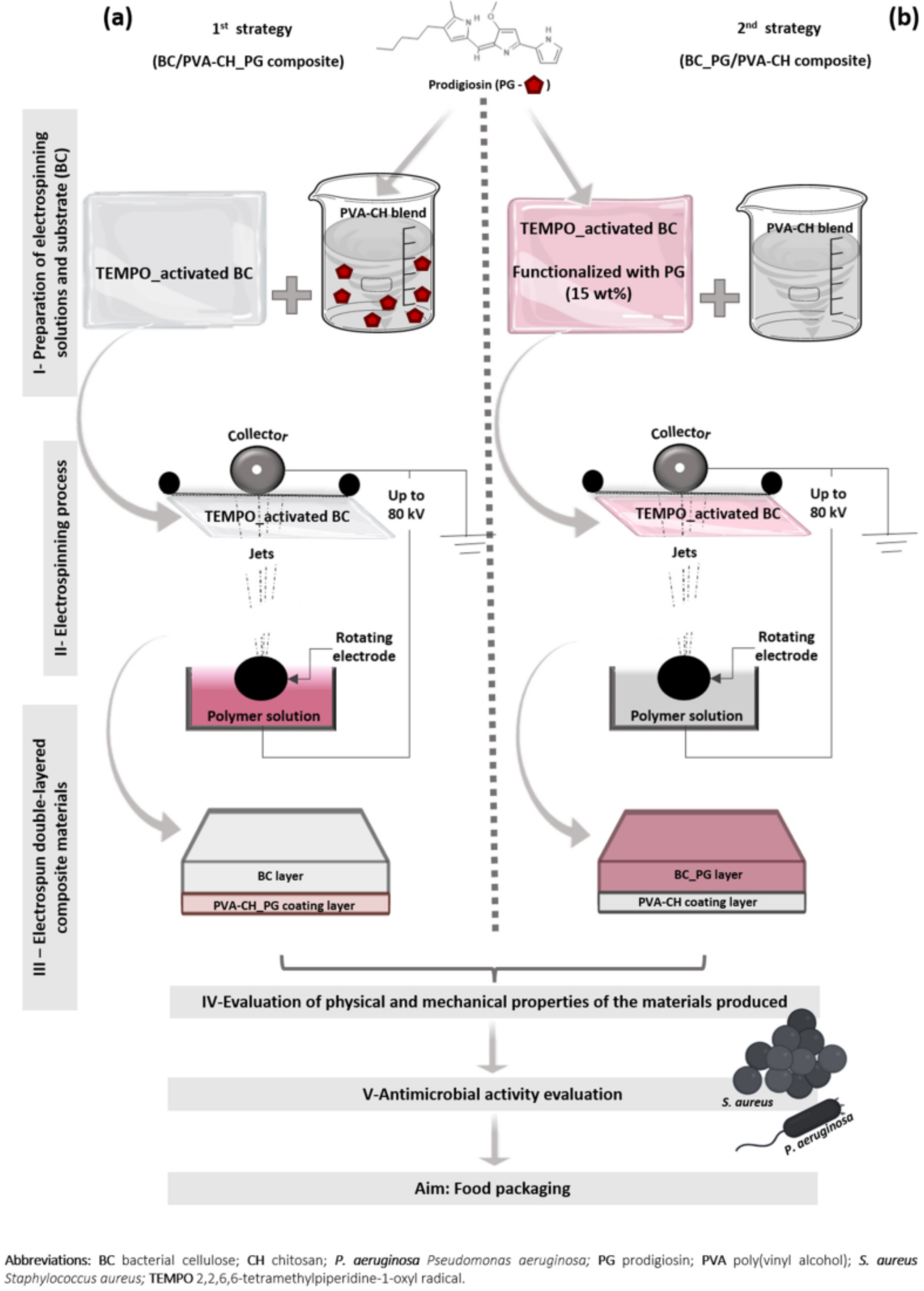

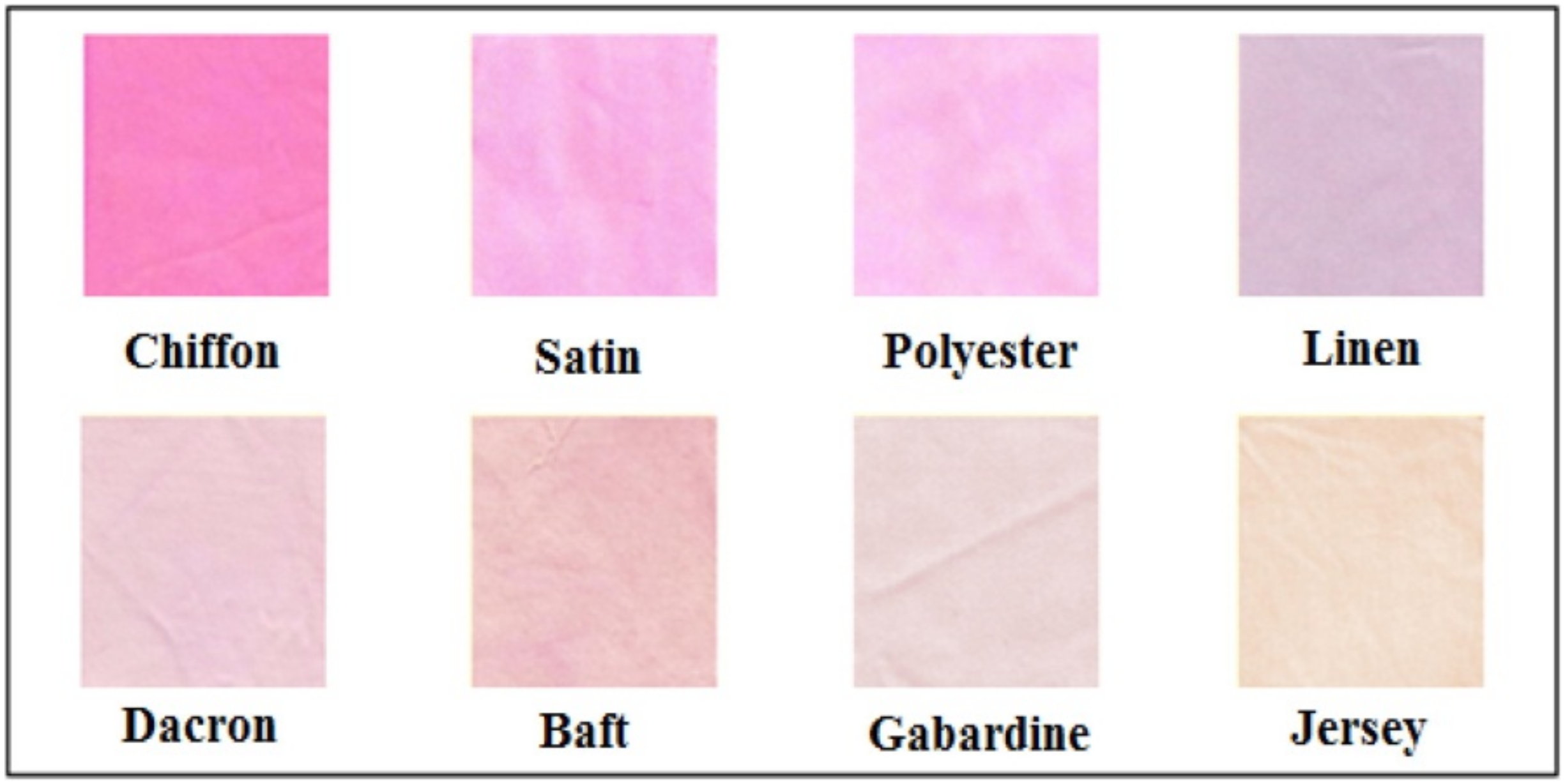

Publisher’s Note: MDPI stays neutral with regard to jurisdictional claims in published maps and institutional affiliations. |
© 2022 by the authors. Licensee MDPI, Basel, Switzerland. This article is an open access article distributed under the terms and conditions of the Creative Commons Attribution (CC BY) license (https://creativecommons.org/licenses/by/4.0/).
Share and Cite
Kramar, A.; Kostic, M.M. Bacterial Secondary Metabolites as Biopigments for Textile Dyeing. Textiles 2022, 2, 252-264. https://doi.org/10.3390/textiles2020013
Kramar A, Kostic MM. Bacterial Secondary Metabolites as Biopigments for Textile Dyeing. Textiles. 2022; 2(2):252-264. https://doi.org/10.3390/textiles2020013
Chicago/Turabian StyleKramar, Ana, and Mirjana M. Kostic. 2022. "Bacterial Secondary Metabolites as Biopigments for Textile Dyeing" Textiles 2, no. 2: 252-264. https://doi.org/10.3390/textiles2020013
APA StyleKramar, A., & Kostic, M. M. (2022). Bacterial Secondary Metabolites as Biopigments for Textile Dyeing. Textiles, 2(2), 252-264. https://doi.org/10.3390/textiles2020013






